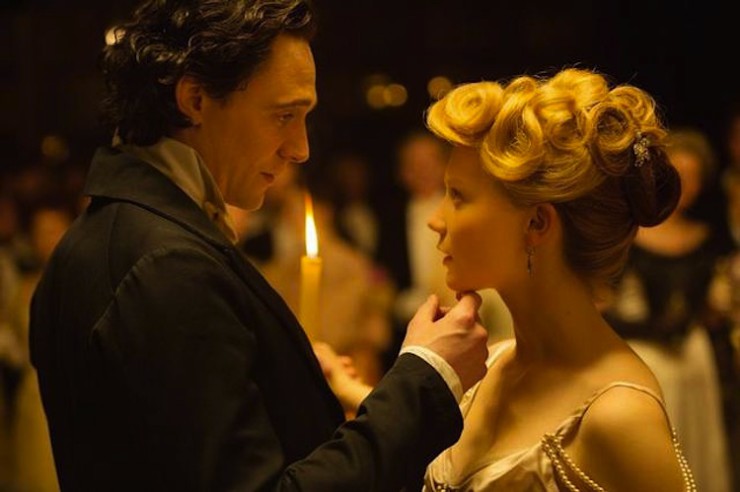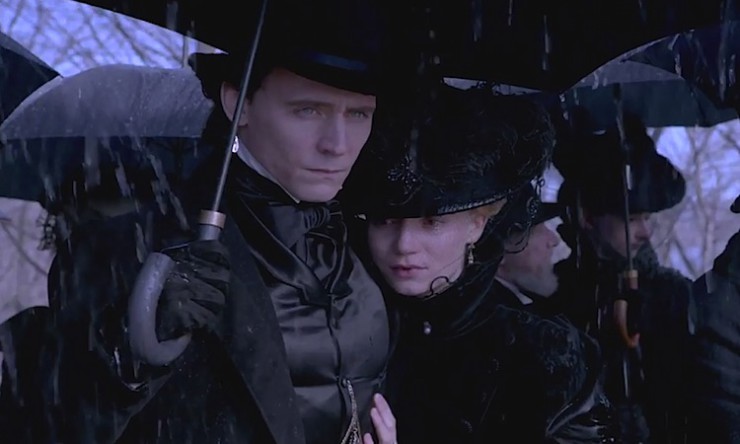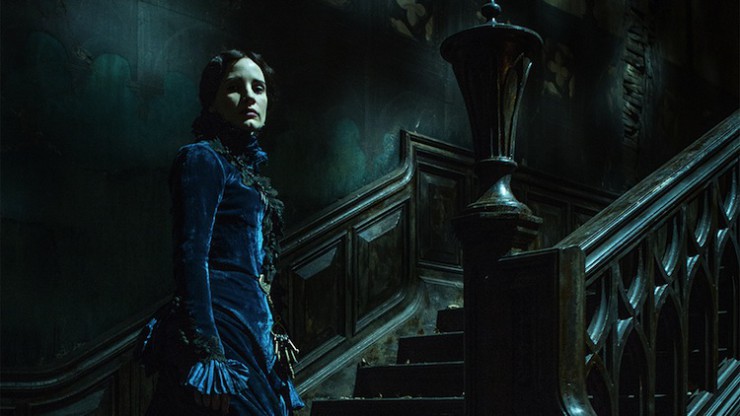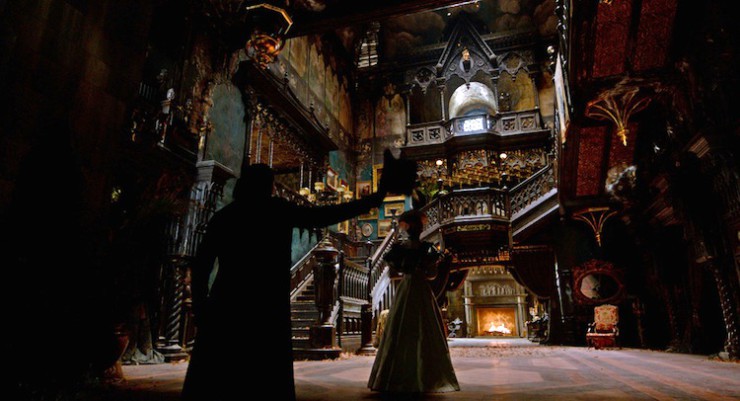Of all the genres, horror and comedy are the most subjective. Western, action, noir, mystery, sci-fi, fantasy—these all must follow certain rules to belong to their genre. You can call something postmodern or meta, but if a gunslinger is trying to right a wrong somewhere in Nevada, it’s probably a Western. If the story is taking place on a spaceship in the future, sci-fi is a safe bet. But horror and comedy…they’re trickier. Is a horror movie a horror movie if it doesn’t scare you? Is a comedy still a comedy if you don’t laugh? Is Crimson Peak a horror film? I would say no, and many of the friends I polled also said no. “Gothic Romance” was the term that came up the most (not a term you hear often outside of graduate seminars and Toast articles), and I think it fits the film. When Crimson Peak is at its best, however, it introduces Gothic tropes, only to stand them on their ominous heads.
2015 has offered moviegoers a fascinating gender studies course, from a working-class update on Cinderella…kinda? (Jupiter Ascending) to the single most feminist movie I’ve ever seen (Fury Road) to disheartening focus on biological motherhood (Avenger: Age of Ultron) to an even more disheartening focus on biological motherhood (Jurassic World), and now we arrive at Crimson Peak.
When we meet Edith Cushing (Mia Wasikowska), we think we’ve just found a classic romantic heroine: beautiful, innocent, virginal, blonde, a dutiful daughter who cares for her father after her mother’s early death. But Edith is a writer, a serious novelist who arrives early for editorial meetings. She learns to type so people will take her more seriously. She is normally ink-stained and editing. She doesn’t fall for Thomas Sharpe (Tom Hiddleston) because of his title, or his money, or even his haunting Hiddlestonian looks—she loves him because he takes her seriously as a writer. In a way, the whole film hinges on her belief in her career, and quietly subverts the whole genre of Gothic Romance as it builds her character.
Where Gothic stories often feature a brooding, imperious, and occasionally abusive male who toys with the emotions of an innocent woman, here Thomas Sharpe is a baronet whose family money has been squandered, desperately trying to salvage his inheritance—the Crimson Peak of the title—by inventing a drill that will maximize the family clay mines. He comes into the story as a classic romantic rogue, all intense gazes and passionate longing, but it soon becomes clear that he has no real control in his own life. Thomas is a dreamer who blinds himself to the realities of his life until it’s far too late. (Between Loki, Adam in Only Lovers Left Alive, and the upcoming Hank Williams biopic I Saw the Light, Tom Hiddleston has carved out a particular niche as a reactive, often passive, antihero.) Rather than the European lord debauching our naive American, it’s Edith who enthusiastically pushes their relationship into physicality. And rather than the young girl being cowed or abused by her new husband, it’s her sister-in-law who she ends up battling while Thomas mostly gets out of her way. But even here, things are complicated.
You’d look at the two female leads and say, Jessica Chastain’s Lucille Sharpe is dark, forbidding, and clearly eeeee-villll, where Edith is a simpering flower, right? But both women are far more complicated than that. Lucille is a complex, multi-layered character, who does wicked things for love, and Edith… Edith is a straight-up heroine. She starts the story as a tough, stubborn young writer, fighting off dismissive male editors, stuck-up society women, her well-meaning father, and eventually the Sharpes themselves for autonomy. She wants to be able to tell her story the way she wants to tell it.
The two men of the story, Lord Sharpe and his rival, Charlie Hunnam’s Dr. Alan McMichael, are largely secondary to the story, as the two women are the ones driving the plot. Actually, Hunnam’s character is in some ways the funniest subversion of all: The buff, blonde, outgoing American doctor is completely out of his element in this story, and the man who would be a hero in most normal movies instead finds his attempts at heroism thwarted, and finds himself in need of rescue more than once.
The other hallmark of the Gothic Romance, the one that usually steals the show, is the haunted, looming architecture, and in this the film surpasses every expectation. Allerdale Hall is a gorgeous, crumbling mansion, with magical attic workshops, ridiculously ornate furniture, vats of blood-red clay, a fire that burns continuously…did I mention that it’s full of giant moths? And that the ceiling’s caving in? And that the whole place is gradually sinking back down into the mines? Del Toro adds a perfect touch in an early scene, when Edith, having just met Lord Sharpe, researches the Hall in a book about English homes. We’re introduced to the house as she is: a black and white sketch of a rambling manor that looks like it would be overflowing with warmth and light. Once Edith arrives, however, it’s clear that the house is just as malevolent as her new sister-in-law. It seems to breathe when the wind blows the right way, and literally bleeds with red clay at times. It even changes shape slightly as her plight becomes more dire. And yet, even with all its obvious flaws, I would move there in a second.
This is also where we come to the one real problem with the film, and one which I was surprised by. Guillermo del Toro has created some of the most horrific imagery of the last decade in Pan’s Labyrinth and The Devil’s Backbone, but the ghosts in Crimson Peak just aren’t that scary. And while I don’t think this was ever meant to be a horror film, but the ghosts are simply too matter-of-fact to generate suspense, which ends up undercutting the tone of the film. Most of the spirits Edith encounters seem to just be there to provide backstory, and in a few cases literally move the plot forward, which is a waste of a good ghost. Since Edith seems to have some ability to communicate with the dead, it’s fair to expect that we’d learn why the ghosts are tethered to Earth, why they can communicate with her particularly, how the ghosts fit into the larger universe, etc. Instead, the film seems content to affirm the usual idea—ghosts are tied to their mortal lives by trauma—and then just leaves it at that. There are a few moments where people are told they have the power to make choices, create their own destinies, but that thread is never really developed. Instead we’re told a very straight-ahead story, with little nuance or subtext.
Having said that, Crimson Peak is a beautiful, utterly unique film, Hiddleston gives us a heartfelt, tortured male lead, Hunnam is appropriately strapping, and, most of all, Wasikowska and Chastain each create fascinating, wonderfully contrasting characters. I recommend seeing it big, particularly if you happen to be a current or former teenage girl who occasionally returns to Manderley in her dreams.
Seriously, if there are any real estate agents out there with lines on crumbling haunted mansions, Leah Schnelbach will take them off your hands. Tell her about them on Twitter!
TKTKTK AUTHOR BIO














A beautiful subversion of a Gothic romance? I don’t agree. And you put forth a very weak argument. I don’t understand exactly how Edith’s attempts at creative writing “subverts” the film or Gothic Romance as a genre. Either you have an odd understanding of what Gothic Romance is or a strange meaning of the word, subvert. CRIMSON PEAK is a very tried and true Gothic storyline, with the standard helpless female victim.
For the record, I adore Del Toro. And I love Gothic Romances. I grew up in the 60’s watching DARK SHADOWS and the Hammer Horror films. But I think Del Toro mis-fired on this film. I found the film to be visually over-wrought and garish and much too thin on plot and character.
SO beautiful and a very welcome focus on that baroque/byzantine fairytale beauty that develops when filmmakers let the sublime aspect of the gothic out of its box, instead of focussing on the horror. And it is a straightforward fairytale film, too (if spoilery to say which one). Perrault and Poe with the merest dash of the shining. I’d watch it with Company of Wolves for decadence.
Is it a subversion so much as a dialling-the-genre-up-to-11? It felt like the saturation had been deepened. Perhaps an examination of the genre by increasing the contrast. Gothic heroines, like fairytale heroines, are fairly commonly self-rescuing (due to circumstance as much as personality).
(The particular and limited roles of both the ghosts and the romantic subplots were explicitly dealt with at least twice in the movie).
Crimson Peak is a fascinating look into madness with great characters, superb atmosphere, evident scares and fantastic, unforgettable visuals.
Edith says near the beginning of the film that her own piece of writing is “A story with a ghost in it”. It isn’t a ghost story. The ghosts are there to help tell the story. The same can be said about the film. Personally, I thought the ghosts were beautiful.